FORD CONTOUR 1999 2.G Service Manual
Manufacturer: FORD, Model Year: 1999, Model line: CONTOUR, Model: FORD CONTOUR 1999 2.GPages: 244, PDF Size: 2.26 MB
Page 41 of 244
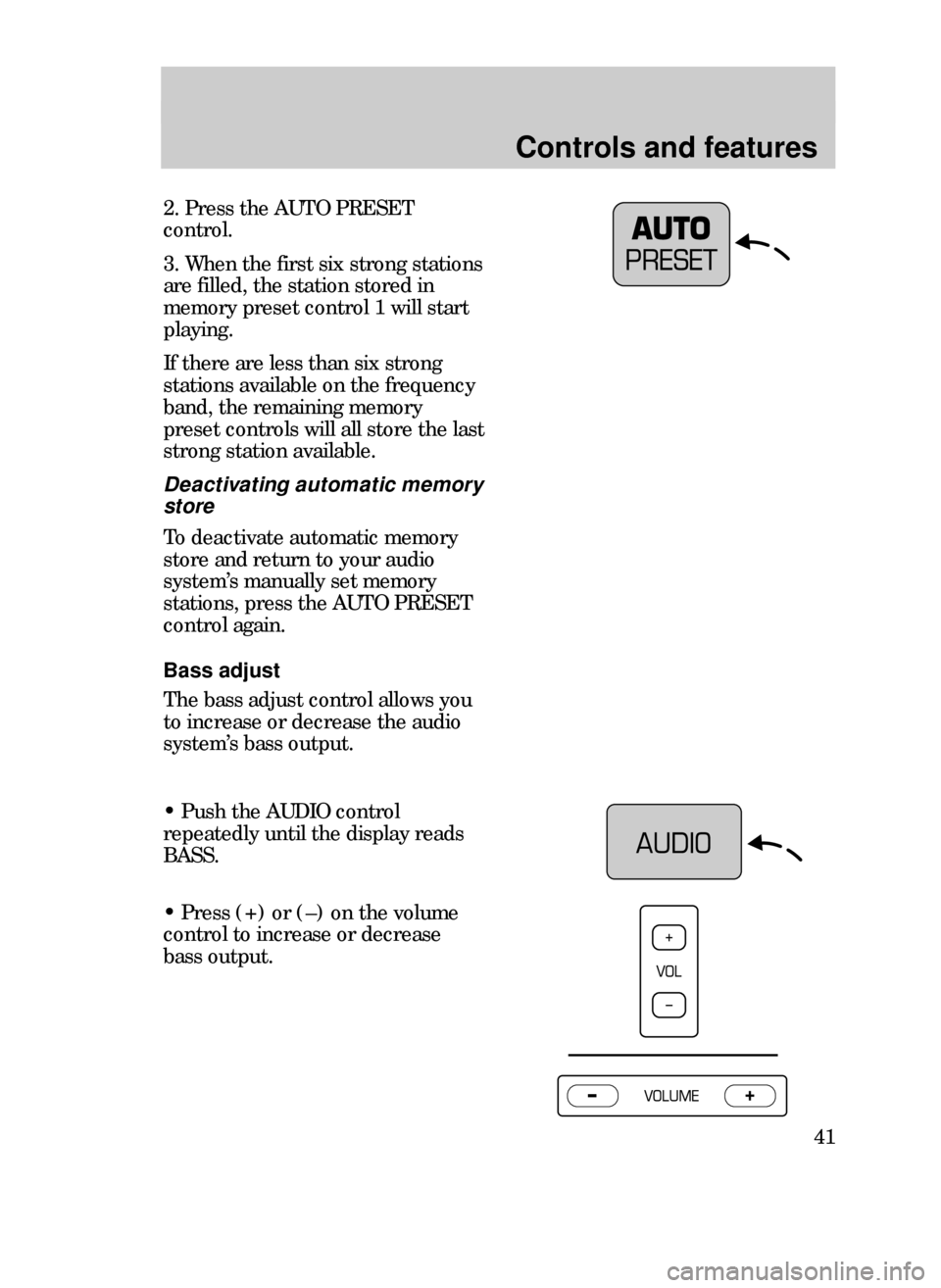
Controls and features
41
2. Press the AUTO PRESET
control.
3. When the first six strong stations
are filled, the station stored in
memory preset control 1 will start
playing.
If there are less than six strong
stations available on the frequency
band, the remaining memory
preset controls will all store the last
strong station available.
Deactivating automatic memory
store
To deactivate automatic memory
store and return to your audio
systemÕs manually set memory
stations, press the AUTO PRESET
control again.
Bass adjust
The bass adjust control allows you
to increase or decrease the audio
systemÕs bass output.
¥ Push the AUDIO control
repeatedly until the display reads
BASS.
¥ Press (+) or (Ð) on the volume
control to increase or decrease
bass output.
13CCfen 3/25/99 1:51 PM Page 41
Page 42 of 244
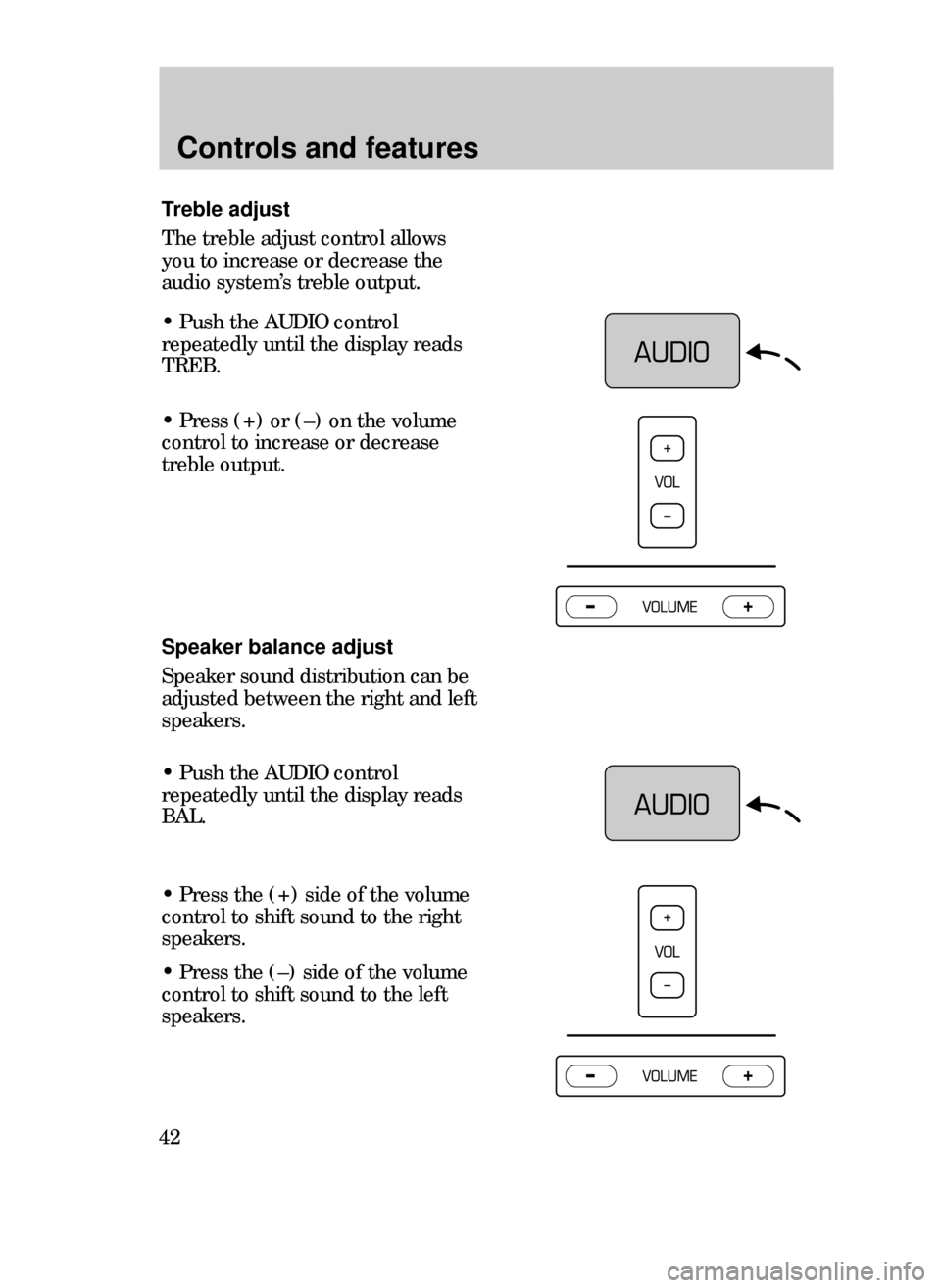
¥ Press (+) or (Ð) on the volume
control to increase or decrease
treble output.
Speaker balance adjust
Speaker sound distribution can be
adjusted between the right and left
speakers.
Controls and features
42
Treble adjust
The treble adjust control allows
you to increase or decrease the
audio systemÕs treble output.
¥ Push the AUDIO control
repeatedly until the display reads
TREB.
¥ Push the AUDIO control
repeatedly until the display reads
BAL.
¥ Press the (+) side of the volume
control to shift sound to the right
speakers.
¥ Press the (Ð) side of the volume
control to shift sound to the left
speakers.
13CCfen 3/25/99 1:51 PM Page 42
Page 43 of 244
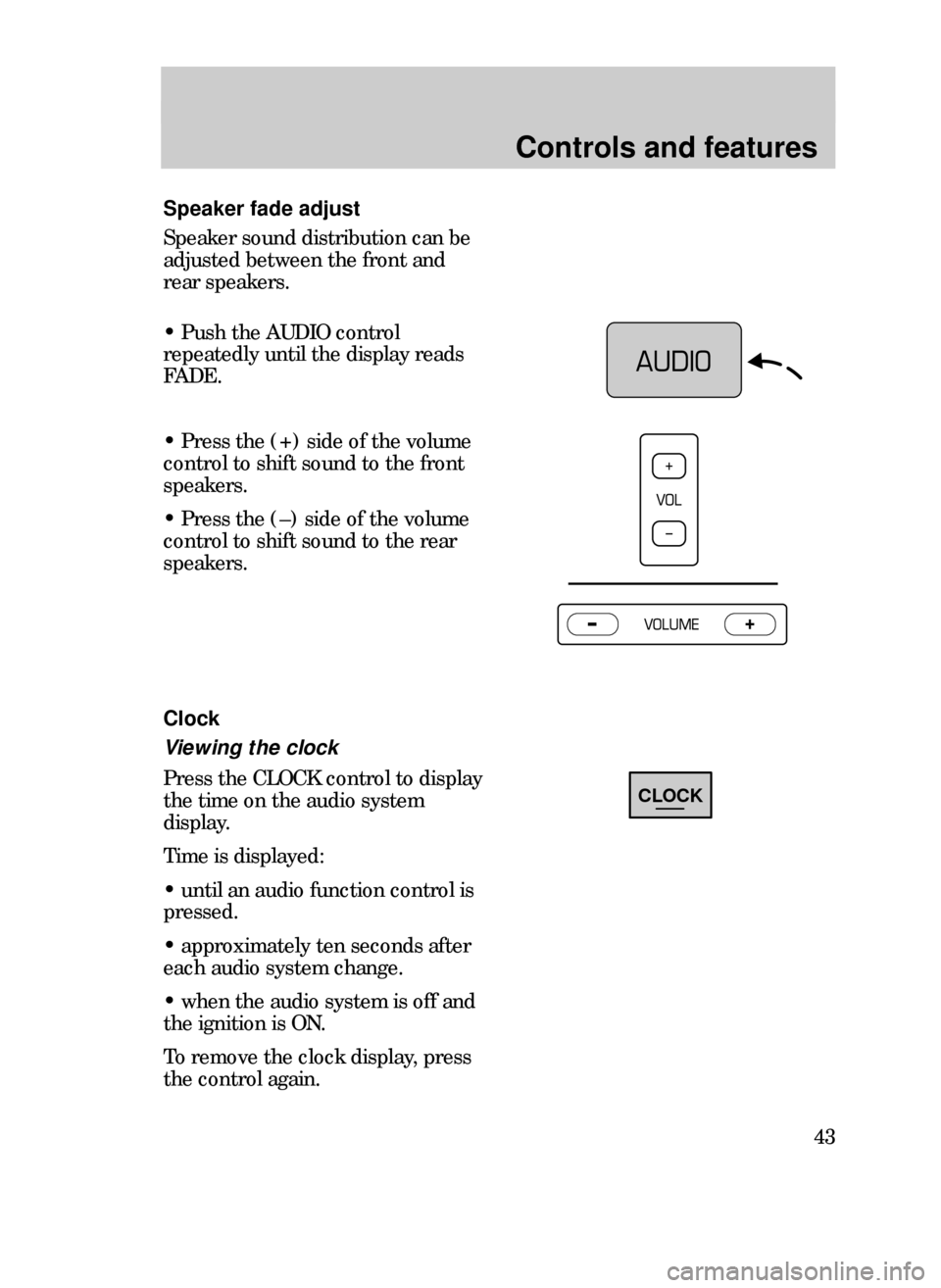
Controls and features
43
Speaker fade adjust
Speaker sound distribution can be
adjusted between the front and
rear speakers.
¥ Push the AUDIO control
repeatedly until the display reads
FADE.
¥ Press the (+) side of the volume
control to shift sound to the front
speakers.
¥ Press the (Ð) side of the volume
control to shift sound to the rear
speakers.
Clock
Viewing the clock
Press the CLOCK control to display
the time on the audio system
display.
Time is displayed:
¥ until an audio function control is
pressed.
¥ approximately ten seconds after
each audio system change.
¥ when the audio system is off and
the ignition is ON.
To remove the clock display, press
the control again.
CLOCK
13CCfen 3/25/99 1:51 PM Page 43
Page 44 of 244
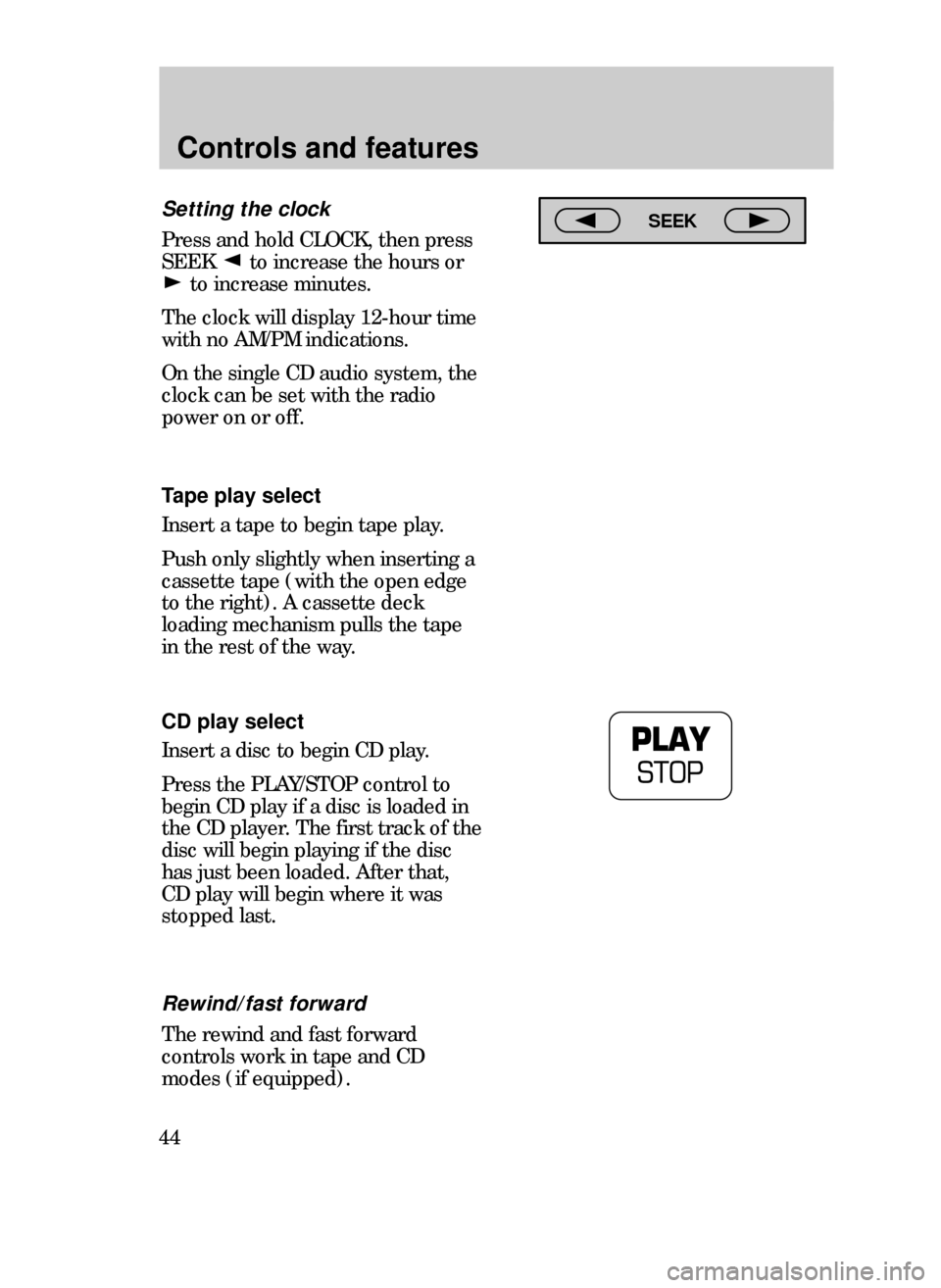
Setting the clock
Press and hold CLOCK, then press
SEEK to increase the hours or
to increase minutes.
The clock will display 12-hour time
with no AM/PM indications.
On the single CD audio system, the
clock can be set with the radio
power on or off.
Controls and features
44
Tape play select
Insert a tape to begin tape play.
Push only slightly when inserting a
cassette tape (with the open edge
to the right). A cassette deck
loading mechanism pulls the tape
in the rest of the way.
CD play select
Insert a disc to begin CD play.
Press the PLAY/STOP control to
begin CD play if a disc is loaded in
the CD player. The first track of the
disc will begin playing if the disc
has just been loaded. After that,
CD play will begin where it was
stopped last.
Rewind/fast forward
The rewind and fast forward
controls work in tape and CD
modes (if equipped).
SEEK
13CCfen 3/25/99 1:51 PM Page 44
Page 45 of 244
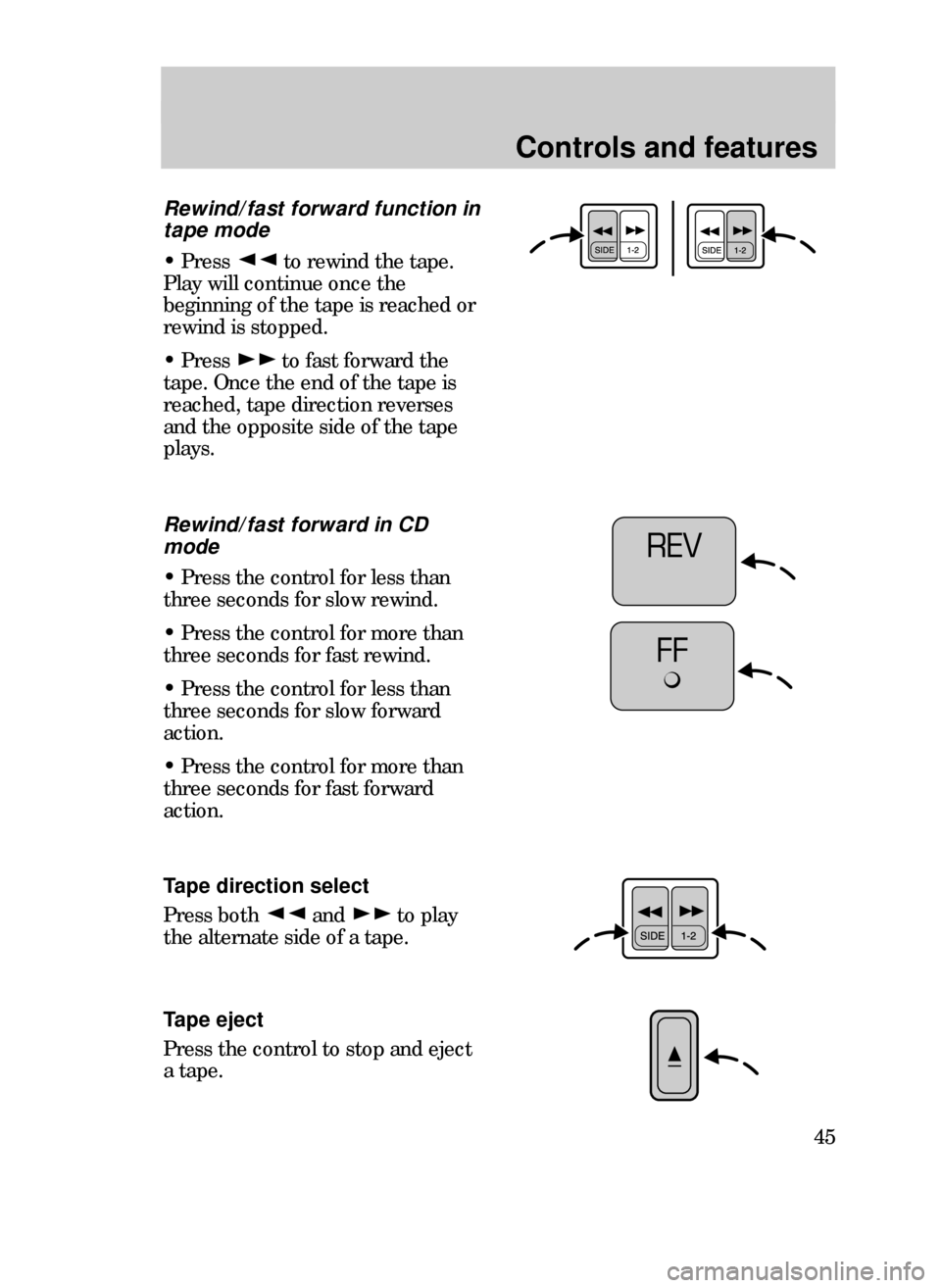
Controls and features
45
Rewind/fast forward in CD
mode
¥ Press the control for less than
three seconds for slow rewind.
¥ Press the control for more than
three seconds for fast rewind.
¥ Press the control for less than
three seconds for slow forward
action.
¥ Press the control for more than
three seconds for fast forward
action.
Tape direction select
Press both and to play
the alternate side of a tape.
Rewind/fast forward function in
tape mode
¥ Press to rewind the tape.
Play will continue once the
beginning of the tape is reached or
rewind is stopped.
¥ Press to fast forward the
tape. Once the end of the tape is
reached, tape direction reverses
and the opposite side of the tape
plays.
Tape eject
Press the control to stop and eject
a tape.
13CCfen 3/25/99 1:51 PM Page 45
Page 46 of 244
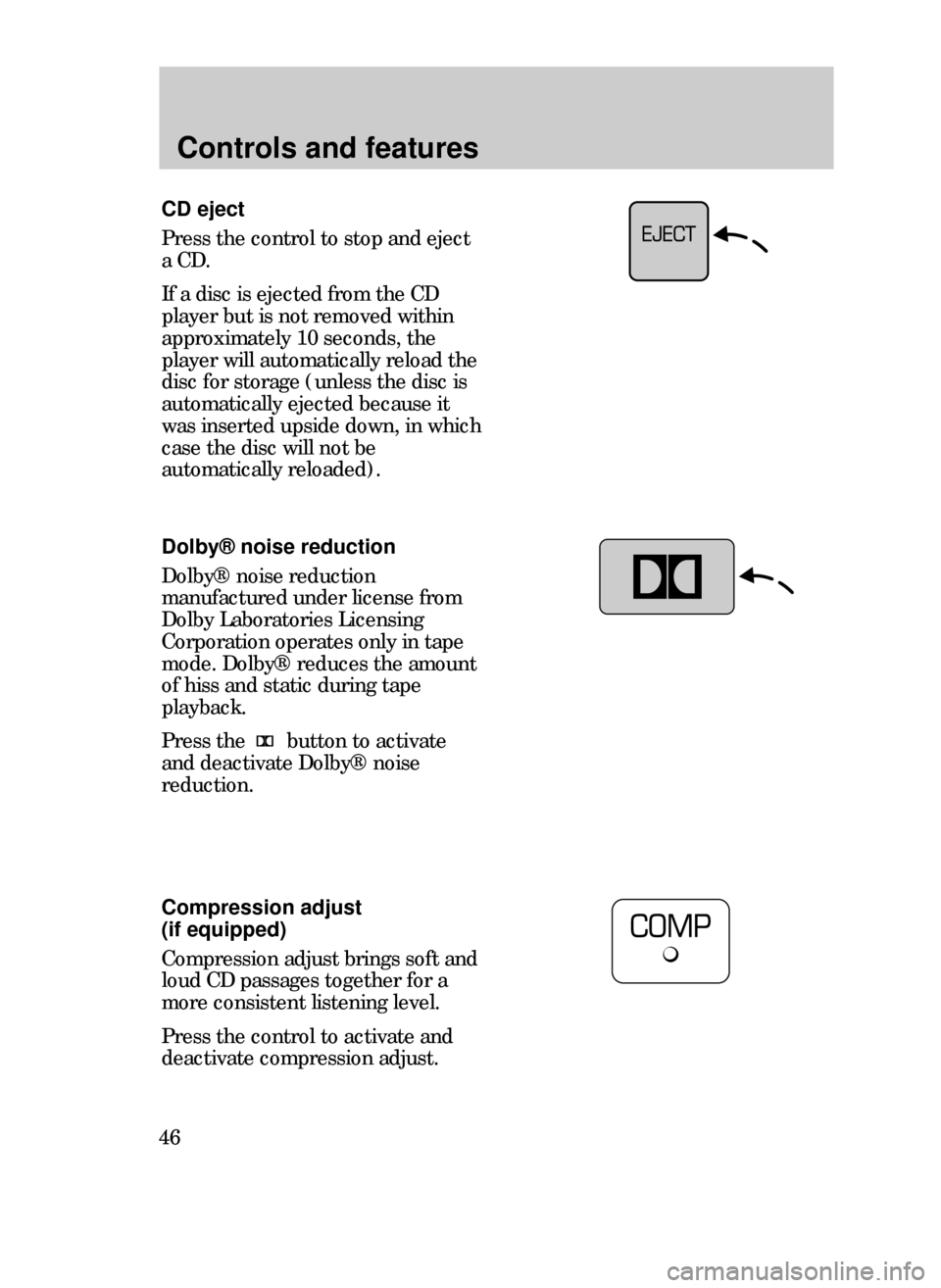
Controls and features
46
CD eject
Press the control to stop and eject
a CD.
If a disc is ejected from the CD
player but is not removed within
approximately 10 seconds, the
player will automatically reload the
disc for storage (unless the disc is
automatically ejected because it
was inserted upside down, in which
case the disc will not be
automatically reloaded).
Dolby¨ noise reduction
Dolby¨ noise reduction
manufactured under license from
Dolby Laboratories Licensing
Corporation operates only in tape
mode. Dolby¨ reduces the amount
of hiss and static during tape
playback.
Press the button to activate
and deactivate Dolby¨ noise
reduction.
Compression adjust
(if equipped)
Compression adjust brings soft and
loud CD passages together for a
more consistent listening level.
Press the control to activate and
deactivate compression adjust.
13CCfen 3/25/99 1:51 PM Page 46
Page 47 of 244
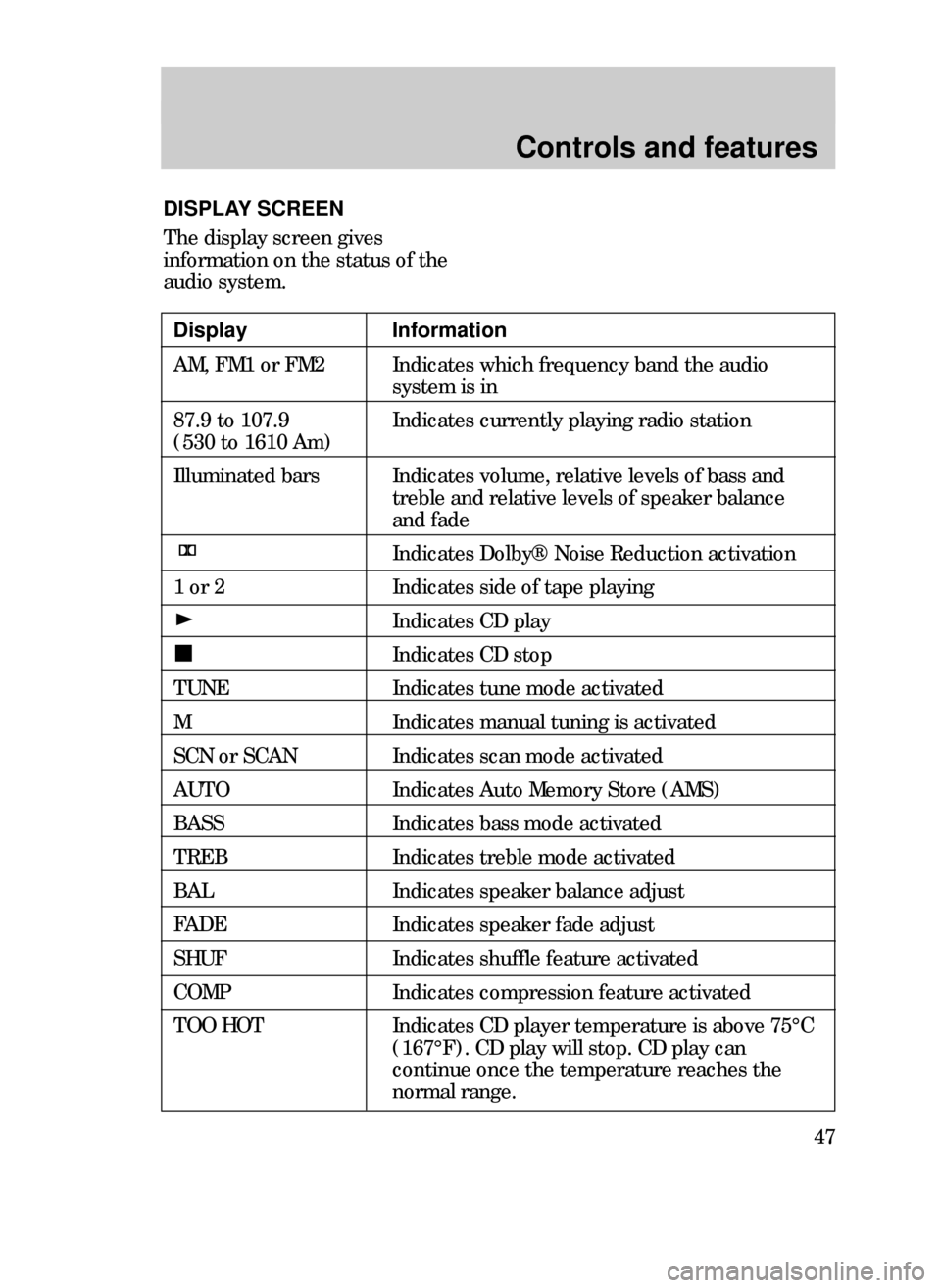
Controls and features
47
DISPLAY SCREEN
The display screen gives
information on the status of the
audio system.
Display Information
AM, FM1 or FM2 Indicates which frequency band the audio
system is in
87.9 to 107.9 Indicates currently playing radio station
(530 to 1610 Am)
Illuminated bars Indicates volume, relative levels of bass and
treble and relative levels of speaker balance
and fade
Indicates Dolby¨ Noise Reduction activation
1 or 2 Indicates side of tape playing
Indicates CD play
Indicates CD stop
TUNE Indicates tune mode activated
M Indicates manual tuning is activated
SCN or SCAN Indicates scan mode activated
AUTO Indicates Auto Memory Store (AMS)
BASS Indicates bass mode activated
TREB Indicates treble mode activated
BAL Indicates speaker balance adjust
FADE Indicates speaker fade adjust
SHUF Indicates shuffle feature activated
COMP Indicates compression feature activated
TOO HOT Indicates CD player temperature is above 75¡C
(167¡F). CD play will stop. CD play can
continue once the temperature reaches the
normal range.
13CCfen 3/25/99 1:51 PM Page 47
Page 48 of 244
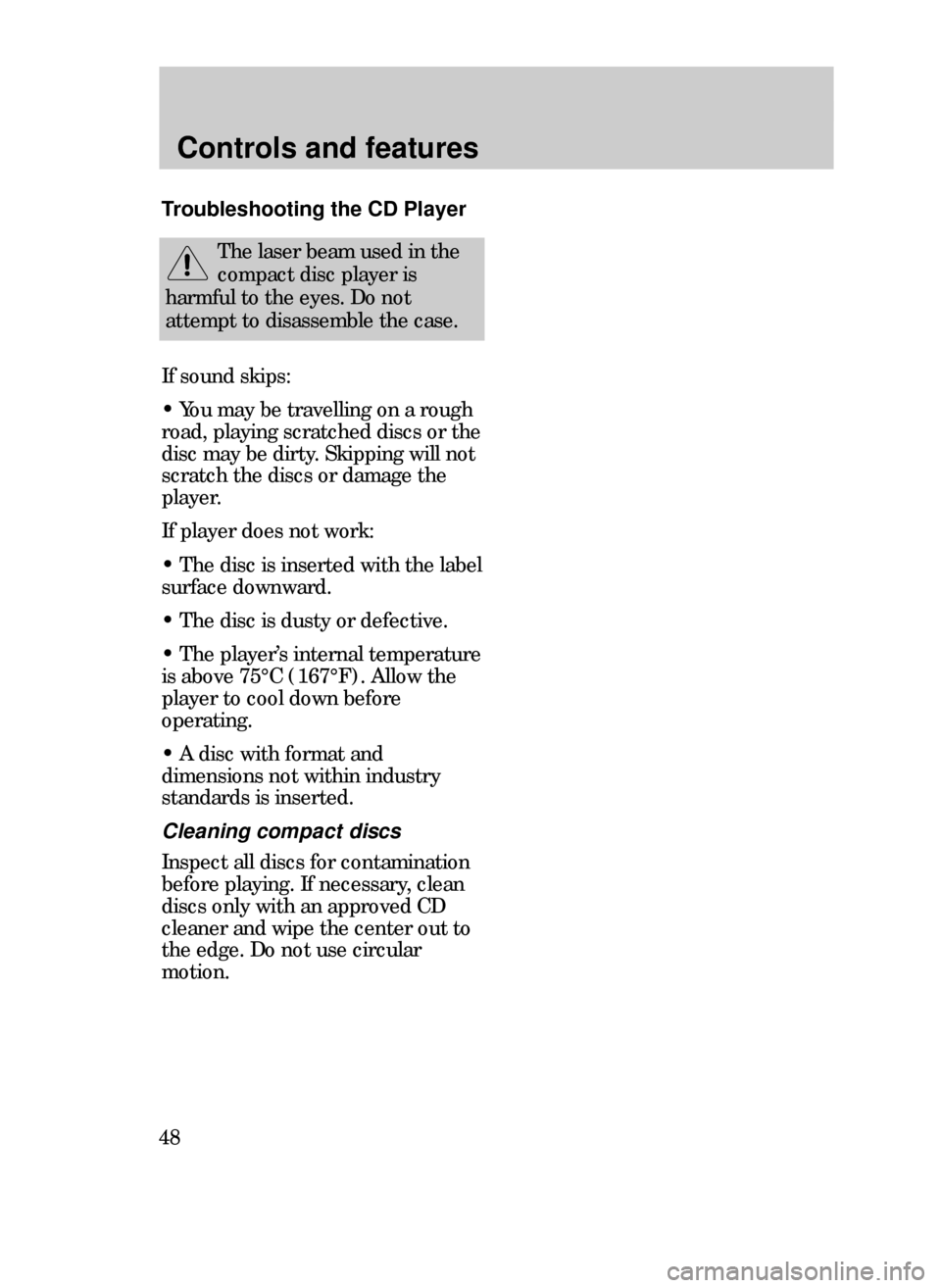
Controls and features
48
Troubleshooting the CD Player
The laser beam used in the
compact disc player is
harmful to the eyes. Do not
attempt to disassemble the case.
If sound skips:
¥ You may be travelling on a rough
road, playing scratched discs or the
disc may be dirty. Skipping will not
scratch the discs or damage the
player.
If player does not work:
¥ The disc is inserted with the label
surface downward.
¥ The disc is dusty or defective.
¥ The playerÕs internal temperature
is above 75¡C (167¡F). Allow the
player to cool down before
operating.
¥ A disc with format and
dimensions not within industry
standards is inserted.
Cleaning compact discs
Inspect all discs for contamination
before playing. If necessary, clean
discs only with an approved CD
cleaner and wipe the center out to
the edge. Do not use circular
motion.
13CCfen 3/25/99 1:51 PM Page 48
Page 49 of 244
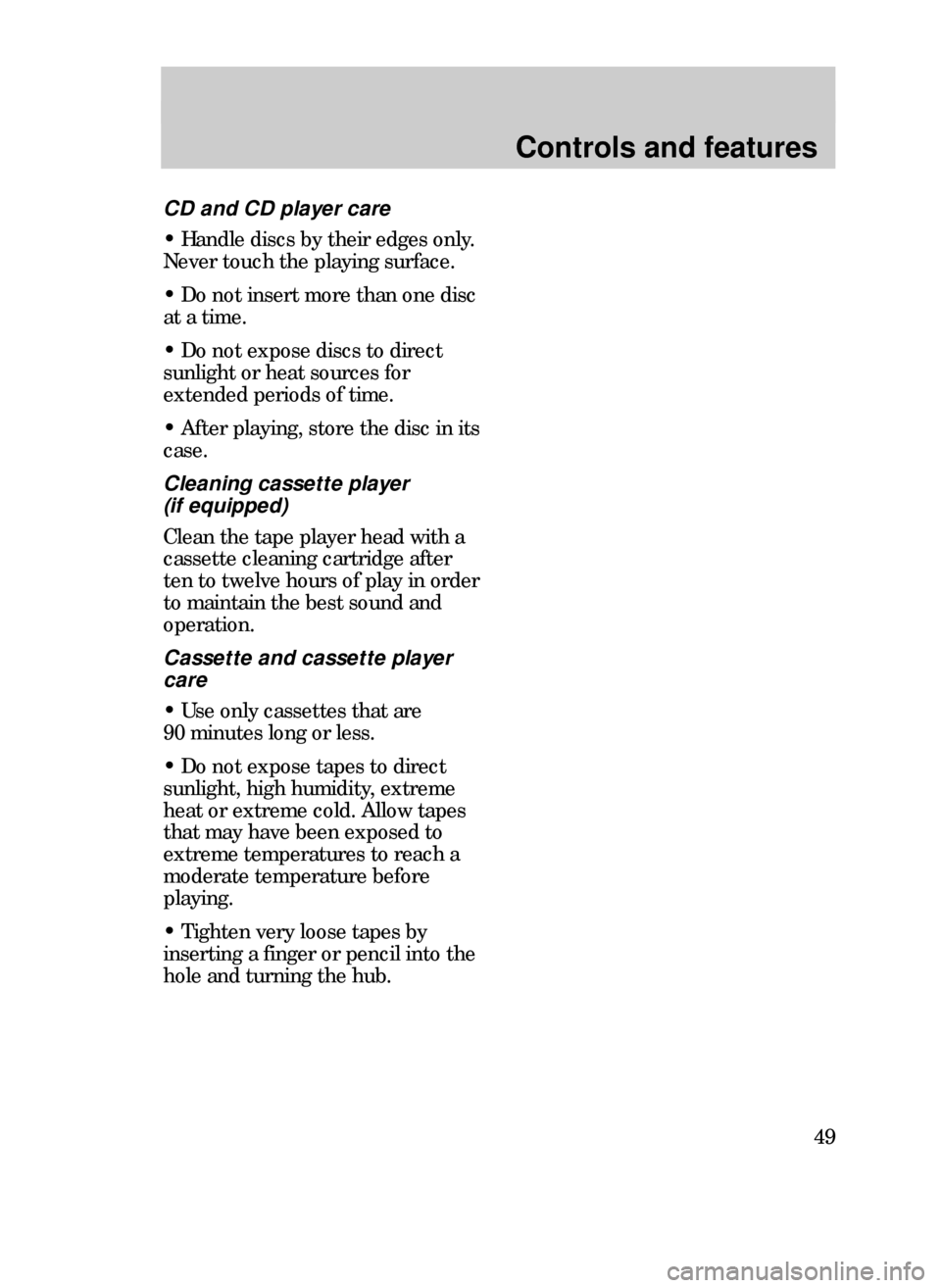
Controls and features
49
CD and CD player care
¥ Handle discs by their edges only.
Never touch the playing surface.
¥ Do not insert more than one disc
at a time.
¥ Do not expose discs to direct
sunlight or heat sources for
extended periods of time.
¥ After playing, store the disc in its
case.
Cleaning cassette player
(if equipped)
Clean the tape player head with a
cassette cleaning cartridge after
ten to twelve hours of play in order
to maintain the best sound and
operation.
Cassette and cassette player
care
¥ Use only cassettes that are
90 minutes long or less.
¥ Do not expose tapes to direct
sunlight, high humidity, extreme
heat or extreme cold. Allow tapes
that may have been exposed to
extreme temperatures to reach a
moderate temperature before
playing.
¥ Tighten very loose tapes by
inserting a finger or pencil into the
hole and turning the hub.
13CCfen 3/25/99 1:51 PM Page 49
Page 50 of 244
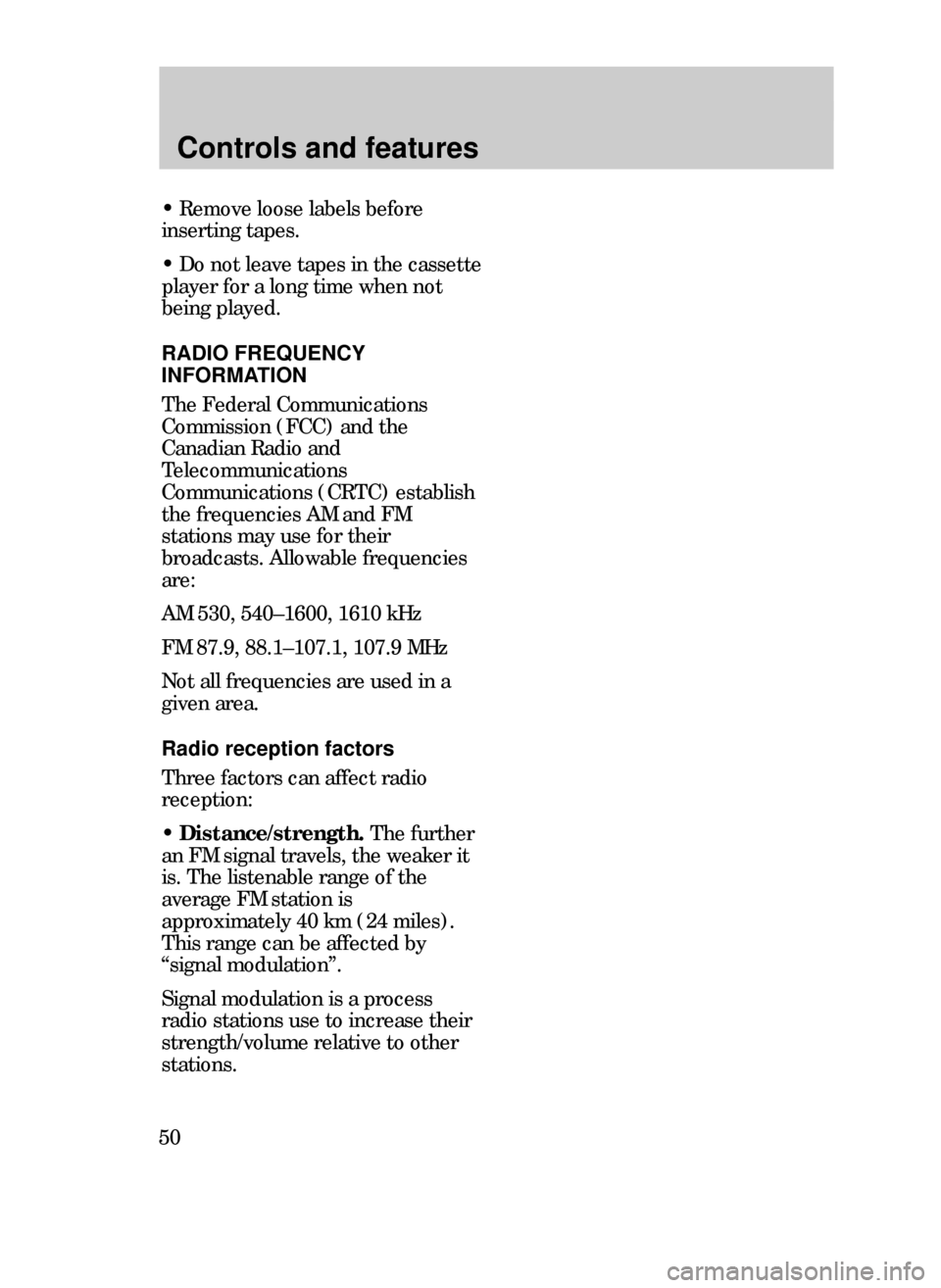
Controls and features
50
¥ Remove loose labels before
inserting tapes.
¥ Do not leave tapes in the cassette
player for a long time when not
being played.
RADIO FREQUENCY
INFORMATION
The Federal Communications
Commission (FCC) and the
Canadian Radio and
Telecommunications
Communications (CRTC) establish
the frequencies AM and FM
stations may use for their
broadcasts. Allowable frequencies
are:
AM 530, 540Ð1600, 1610 kHz
FM 87.9, 88.1Ð107.1, 107.9 MHz
Not all frequencies are used in a
given area.
Radio reception factors
Three factors can affect radio
reception:
¥Distance/strength.The further
an FM signal travels, the weaker it
is. The listenable range of the
average FM station is
approximately 40 km (24 miles).
This range can be affected by
Òsignal modulationÓ.
Signal modulation is a process
radio stations use to increase their
strength/volume relative to other
stations.
13CCfen 3/25/99 1:51 PM Page 50